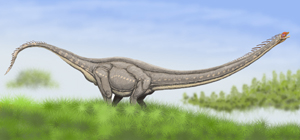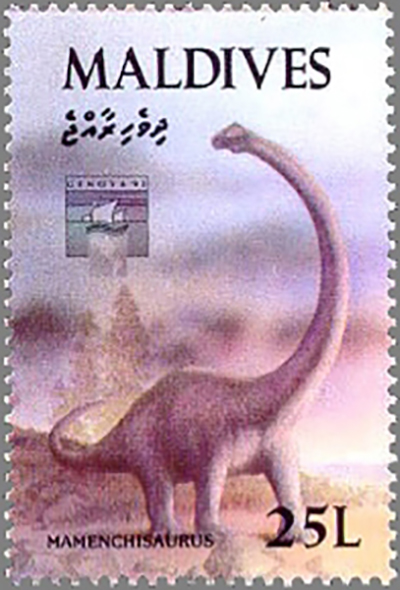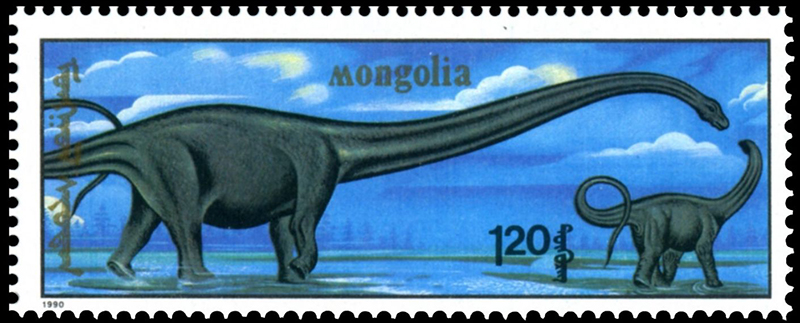Mamenchisaurus constructus Young, 1954

Phylum: Chordata Haeckel, 1874
Subphylum: Vertebrata Cuvier, 1812
Classe: Dinosauria Owen, 1841
Ordine: Saurischia Seeley, 1887
Famiglia: Euhelopodidae Romer, 1956
Genere: Mamenchisaurus Young, 1954
Specie e sottospecie
Il genere annovera attualmente le seguenti specie: Mamenchisaurus anyuensis He et al., 1996 - Mamenchisaurus guangyuanensis Li & Cai, 1997 (Nomen nudum) - Mamenchisaurus hochuanensis Young & Zhao, 1972 - Mamenchisaurus jingyanensis Zhang, Li & Zeng, 1998 - Mamenchisaurus sinocanadorum Russell & Zheng, 1993 - Mamenchisaurus youngi Pi, Ouyang & Ye, 1996 - Mamenchisaurus yunnanensis Fang et al., 2004.
Descrizione
Era lungo 22 m, dalla punta della coda all'estremità del muso; 11 m circa erano costituiti dal collo. Questo dinosauro possedeva infatti il collo più lungo di qualsiasi altro animale mai vissuto sulla terra, si stima avesse un’altezza di 5 m al garrese. Il nome Mamenchisaurus significa lucertola di Mamenchi (dall'omonima localtà cinese dove furono trovati i fossili). Era erbivoro. L'esteso collo del mamenchisauro era sorretto da lunghe ossa sovrapposte, che lo rendevano piuttosto rigido e lento nei movimenti; esso aveva anche una robusta muscolatura capace di sorreggere la piccola testa. Il mamenchisauro era lungo come un campo da tennis, ma aveva una corporatura piuttosto magra con un peso di 30-50 tonnellate. La colonna vertebrale era cava in alcuni punti, e dunque risultava notevolmente alleggerita. L'area in cui questo dinosauro viveva, 145 milioni di anni fa, era ricoperta da vaste e dense foreste di sandalo e sequoie. I mamenchisauri vi pascolavano, brucando foglie e germogli delle cime degli alberi, che erano oltre la portata degli altri dinosauri, con i piccoli denti a piolo. Il mamenchisauro procedeva sulle quattro zampe, trascinando a terra dietro di sé la lunga coda sottile. Durante la stagione dell'accoppiamento, i maschi probabilmente se ne servivano come di una pericolosa frusta con cui colpirsi nei combattimenti ingaggiati per la conquista delle femmine.
Diffusione
145 milioni di anni fa, in Cina, nel Giurassico superiore.
Bibliografia
–Wang, J.; Norell, M. A.; Pei, R.; Ye, Y.; Chang, S.-C (2019). "Surprisingly young age for the mamenchisaurid sauropods in South China". Cretaceous Research. 104: 104176.
–Sues, Hans-Dieter (1997). "Sauropods". In James Orville Farlow; M. K. Brett-Surman (eds.). The Complete Dinosaur. Bloomington: Indiana University Press. pp. 274.
–Norman, David B. (2004). "Dinosaur Systematics". In Weishampel, D.B.; Dodson, P.; Osmólska, H. (eds.). The Dinosauria (2nd ed.). Berkeley: University of California Press. pp. 318.
–Russell, D.A., Zheng, Z. (1993). "A large mamenchisaurid from the Junggar Basin, Xinjiang, People Republic of China." Canadian Journal of Earth Sciences, (30): 2082-2095.
–Paul, G.S. (2016). The Princeton Field Guide to Dinosaurs, Princeton University Press.
–Paul, Gregory S. (2019). "Determining the largest known land animal: A critical comparison of differing methods for restoring the volume and mass of extinct animals" (PDF). Annals of the Carnegie Museum. 85 (4): 335-358.
–Young, C.C. (1954), On a new sauropod from Yiping, Szechuan, China. sinica, III(4), 481-514.
–Origin of the Mamenchisaurus name Archived 2007-09-27 at the Wayback Machine (in Chinese), Beijing Museum of Natural History website.
–Young, C. C. (1958). "New Sauropods from China". Vertebrata PalAsiatica. 2 (1).
–Young, C.C., and Zhao, X.-J. (1972). "Mamenchisaurus hochuanensis sp. nov." Institute of Vertebrate Paleontology and Paleoanthropology Monographs, A, 8:1-30.
–Glut, Donald F. (2000). Dinosaurs: The Encyclopedia: Supplement 1. North Carolina: Jefferson: McFarland & Company.
–Moore, A.J.; Upchurch, P.; Barrett, P.M.; Clark, J.M.; Xing, X. (2020). "Osteology of Klamelisaurus gobiensis (Dinosauria, Eusauropoda) and the evolutionary history of Middle–Late Jurassic Chinese sauropods" (PDF). Journal of Systematic Palaeontology. 18 (16): 1299-1393.
–Moore, Andrew J.; Barrett, Paul M.; Upchurch, Paul; Liao, Chun-Chi; Ye, Yong; Hao, Baoqiao; Xu (2023). "Re-assessment of the Late Jurassic eusauropod Mamenchisaurus sinocanadorum Russell and Zheng, 1993, and the evolution of exceptionally long necks in mamenchisaurids". Journal of Systematic Palaeontology. 21 (1).
–Paul, Gregory (2019-12-31). "Determining the Largest Known Land Animal: A Critical Comparison of Differing Methods for Restoring the Volume and Mass of Extinct Animals". Annals of Carnegie Museum. 85 (4): 335.
–He, Xinlu; Yang, Suihua; Cai, Kaiji; Li, kui; Liu, Zongwen (1996). "A new species of sauropod, Mamenchisaurus anyuensis sp. nov." (PDF). Papers on Geosciences Contributed to the 30th Geological Congress: 83-86.
–PI, L., OU, Y. and YE, Y. 1996. A new species of sauropod from Zigong, Sichuan, Mamenchisaurus youngi. 87-91. In DEPARTMENT OF SPATIAL PLANNING AND REGIONAL ECONOMY (ed.), Publication in Geoscience Contributed to the 30th International Geological Congress. China Economic Publishing House, Beijing.
–Zhang, Yihong; Li, kui; Zeng, Qinghua (1998). "'A new species of sauropod from the Late Jurassic of the Sichuan Basin (Mamenchisaurus jingyanensis sp. nov.)'". Journal of the Chengdu University of Technology. 25 (1): 61-68.
–Xing, L; Ye, Y; Shu, C; Peng, G; You, H (2009). "Structure, orientation and finite element analysis of the tail club of Mamenchisaurus hochuanensis". Acta Geologica Sinica (English Edition). 83 (6): 1031-1040.
–Hou, Lianhai; Zhou, Shiwu; Cao, Youshu (1976). "New discovery of sauropod dinosaurs from Sichuan" (PDF). Vertebrata PalAsiatica (in Chinese and English). 14 (3): 160-165.
–Peng, G.Z.; Ye, Y.; Gao, Y.H.; Shu, C.K.; Jiang, S. (2005). "Jurassic dinosaur faunas in Zigong". Zigong Dinosaur Museum, Zigong.
–Zhang, Y.; W. Chen (1996). "Preliminary research on the classification of sauropods from Sichuan Basin, China". In Morales, M. (ed.). The Continental Jurassic. Museum of Northern Arizona Bulletin, 60. Museum of Northern Arizona. pp. 97-107.
–Upchurch, Paul; Barrett, Paul M.; Dodson, Peter (2004). "Sauropoda". The Dinosauria. Weishampel, David B., Dodson, Peter., Osmólska, Halszka. (2nd ed.). Berkeley, Calif.: University of California Press.
–Li, Kui; Cai, Kaiji (1997). "Classification and evolution of Mamenchisaurus". Journal of Chengdu University of Technology. 24: 102-107.
–Ouyang, H. and Ye, Y. 2002. The First Mamenchisaurian Skeleton with Complete Skull: Mamenchisaurus youngi (in Chinese with English summary). 111 pp + 20 plates. Sichuan Science and Technology Press, Chengdu.
–FANG, Xiaosi; ZHAO, Xijin; LU, Liwu; CHENG, Zhengwu (2004). "Discovery of Late Jurassic Mamenchisaurus in Yunnan, southwestern China". Regional Geology of China Z. 23.

|
Data: 01/01/2009
Emissione: Animali preistorici Stato: Equatorial Guinea |
|---|

|
Data: 15/09/1992
Emissione: Dinosauri Stato: Maldives |
|---|

|
Data: 01/01/2010
Emissione: Celebri paleontologi e dinosauri Stato: Mali |
|---|

|
Data: 25/08/1990
Emissione: Animali preistorici Stato: Mongolia |
|---|